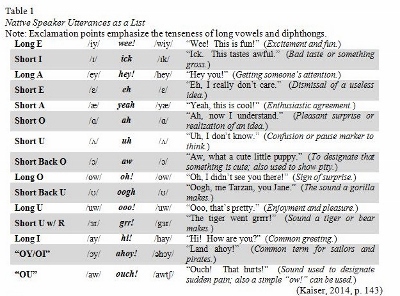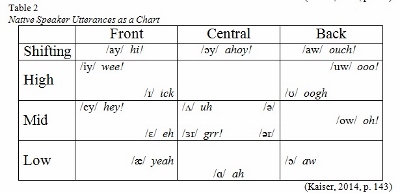|
Vowel sounds are a challenge for any English language learner
(ELL), from the elementary school student through the business
professional, and for learners in both ESL and EFL settings. If
listening and speaking is one of your learners’ goals, it is virtually
impossible to avoid teaching vowel sounds to achieve comprehensibility. A
common set of English vowels and vowel features (such as vowel length
and quality) that constitute a “common core” or a “lingua franca core”
has been debated in the context of English as an international language
or as a lingua franca (see Jenkins, 2000; Jenner, 1989; Walker, 2010).
Despite this global diversity and individual variability, a “common
core” of 15 tonic (stressed) North American vowels can be identified
based on published pronunciation textbooks (see my textbook survey in
Kaiser, 2014).
With a target variety selected (in this particular case, North
American English), the issue becomes choosing an effective method to
teach this set of vowels. As I have argued previously (Kaiser, 2014),
the use of traditional “key” or “chart” words is often ineffective
because the selected words often form minimal pairs or may easily be
mispronounced by learners already. For example, several textbooks use beat, bit, bate, bet, and bat as
example words for learners to use as a reference for the correct
pronunciation of the five front vowels (see Cook, 2000, p. 73; Dauer,
1993, p. 26; Hagen & Grogan, 1992, p. 16; Handschuh &
Simounet de Geigel, 1985, p. 4; Lane, 2005, p. 2; Prator &
Robinett, 1972, p. 13). For this reason, I have advocated for using
“native speaker utterances” (NSUs) as a more appropriate vowel modeling
system for both teaching and reviewing vowel sounds (Kaiser, 2014). In
this short article I present my vowel modeling system for teaching North
American vowel sounds, discuss NSUs, and focus on how to use this model
in both teaching and tutoring situations.
Native Speaker Utterances
Learners often mispronounce key vowel sounds needed to make the
fine-tune distinctions required for the 15 tonic (stressed) vowel
sounds found in most standard varieties of North American English. NSUs
move away from already mispronounced words and place more focus on the
vowel sound itself, while giving it a particular meaning in a
communicative context. For example, rather than using the word bead or week for the high front
long vowel (which ELLs may mispronounce as bid or wick), the NSU model uses wee! As
an utterance, the focus on the vowel sound is stronger (because wi with a short I does not evoke excitement as does wee! with a long E). Although Celce-Murcia, Brinton,
and Goodwin (2010) also present “vowels with communicative meaning in
English” (p. 151) in their book Teaching
Pronunciation, they do not present utterances for the full
range of vowels in North American English. Table 1 presents my complete
model of NSUs in a list form, and Table 2 presents the same model as a
vowel chart.
Click on tables to enlarge


NSUs in Instruction
With learners at any level, NSUs can be used both to introduce
and to review vowel sounds. NSUs are also useful for error correction
and can even be used by learners themselves as they monitor their own
pronunciation. This model works well in a designated class or unit on
pronunciation, but can also be incorporated into any speaking class or
lesson. The key to making NSUs more effective is repetition and frequent
review so that learners can quickly access these utterances as models
for the full range of target vowel sounds to promote vowel
fluency.
Before using NSUs with your learners, you may need to adapt
this vowel modeling system. Not every variety of North American English
makes a distinction between /ɑ/ and /ɔ/ (in which case, you may collapse
the two into one appropriate utterance). You may also want to replace
particular NSUs with ones that feel more comfortable to you (several
colleagues have suggested oy! for ahoy!). Many of these NSUs could have different
meanings based on context. You should choose meanings that work for you
and your learners. For example, aw could be aw, how cute (complimenting something cute), aw, shucks (deflecting a compliment), or aw,
man (disappointment or irritation). The key is to use a full
set of NSUs for all stressed vowels in the target variety and to provide
a communicative meaning that will be memorable for learners.
As a first step to promote vowel fluency, I include NSUs in my
introduction to vowel sounds. This requires making a distinction between
stressed and unstressed vowels (there are no NSUs for the unstressed
/ə/ or /ər/ because they cannot be uttered in isolation). Learners
should also be introduced to the difference between long (tense) and
short (lax) vowels in English (note that the long NSUs have exclamation
points to show this difference). I use both the list and chart to
introduce NSUs to learners, but for later reference and review I always
rely on the chart. The chart shows the vowel sounds in relation to each
other based on tongue position. A facial diagram (found in many
pronunciation texts) may be used in connection with this chart (so long
as the diagram has the lips on the left-hand side). The chart is a good
visual reference for learners to see why particular sounds may be
difficult for them to distinguish (whether that be hearing or
pronouncing the difference).
When presenting NSUs, it is crucial to make an explicit
connection between the vowel sound in the utterance and the pure vowel
sound. Choral repetition is an effective way to introduce and review
these sounds. In the earlier stages, this can be done in three steps.
First, take learners through only the NSUs: wee!, ick,
hey! Next, have learners repeat the NSU and then the pure
vowel: wee!, /iy/, ick, /ɪ/, hey!, /ey/. Finally, go through the chart using the
vowel sounds only: /iy/, /ɪ/, /ey/. In each case, learners should be
repeating after you. As learners become more familiar with this model,
they may recite the utterances and/or vowels together or individually
without the you modeling them first. The goal is for learners to access
these NSUs readily as models that have been appropriated into their own
set of English language skills. With appropriate practice, this model
promotes vowel fluency, whereby learners can readily distinguish North
American vowel sounds when both listening and speaking.
A visual reference of the NSU chart can be helpful for
learners. In K–12 settings where the instructor may have more control of
the classroom, a poster with the NSUs and vowel sounds may be used. If
transcription symbols would be too advanced for your learners, they may
be replaced with a simplified transcription system (such as ē, i, ā, e,
etc.). A data projector or overhead projector may be used to display the
NSU chart on a screen for review. In tutoring situations and classroom
settings, handouts are effective and learners can refer to them at
home.
In pronunciation classes, the NSU chart may be reviewed before
and after an explicit lesson on a particular vowel contrast. In a class
that involves public speaking or giving presentations, NSUs can be a
great warm-up for the class (similar to warm-up exercises done by
actors). Practicing NSUs with others and individually can help the
quieter learners who need practice speaking up (because these utterances
require being loud). If you do private tutoring, whether it be
conversation practice or English for specific purposes, NSUs are great
as a warm-up activity and review.
After NSUs have properly been introduced, they may be used for
error correction. When a learner mispronounces a vowel, the appropriate
NSU may be used. For example, if a learner says “maintAHn” (/meyntɑ́n/),
you can note that the vowel is /ey/ as in hey! I
have even seen learners use NSUs for their own error correction. Through
frequent review in our classes, they develop the vowel fluency to
monitor their own pronunciation and recognize when their vowel
production does not match their prediction. When you see learners stop,
recite the NSU for a particular vowel, and then repeat the word with the
correct vowel sound, learners are developing vowel fluency.
Learners young and old find NSUs fun, and they are far more
memorable and meaningful than a list of “key” or “chart” words. NSUs are
easy to introduce in the classroom or during tutoring sessions, and
they do not have to be limited to pronunciation classes or lessons. If
your goal is for your learners to acquire a full set of North American
vowel sounds that they can distinguish in both listening and speaking,
this may be a helpful model to promote their vowel fluency, strengthen
their intelligibility, and use instruction time more
effectively.
References
Celce-Murcia, M., Brinton, D., & Goodwin, J. M. (2010).Teaching pronunciation: A course book and reference
guide. New York, NY: Cambridge University Press.
Cook, A. (2000). American accent training. Hauppauge, NY: Baron’s Educational Series.
Dauer, R. M. (1993). Accurate English: A complete
course in pronunciation. Englewood Cliffs, NJ:
Regents/Prentice Hall.
Hagen, S. A., & Grogan, P. E. (1992). Sound
advantage: A pronunciation book. Englewood Cliffs, NJ:
Prentice-Hall.
Handschuh, J., & Simounet de Geigel, A. S. (1985). Improving oral communication. Englewood Cliffs, NJ:
Prentice-Hall.
Jenkins, J. (2000). The phonology of English as an
international language: New models, new norms, new goals.
Oxford, England: Oxford University Press.
Jenner, B. (1989). Teaching pronunciation: The common core. Speak Out! 4, 2–4.
Kaiser, D. (2014). Grunt and cheer: Teaching North American
vowels through native speaker utterances. In The Conference
Proceedings of MIDTESOL: Cultivating Best Practices in ESL,
2012 (pp. 133–149). Retrieved from http://midtesol.org/docs/MIDTESOL_Proceedings_2012.pdf
Lane, L. (2005). Focus on pronunciation: 3. White Plains, NY: Longman.
Prator, C. H., Jr., & Robinett, B. W. (1972). Manual of American English pronunciation. New York,
NY: Holt, Rinehart and Winston.
Walker, R. (2010). Teaching the pronunciation of
English as a lingua franca. Oxford, England: Oxford University
Press.
DJ Kaiser, PhD, is an assistant professor and
coordinator of TESL at Webster University, in St. Louis, Missouri. He
has taught ESL at the University of Illinois, Parkland Community
College, and Washington University in St. Louis and has also been a
visiting professor at the University of Barcelona. He has presented on
topics such as pronunciation, translation studies, ELT, and program
development throughout the United States and in China, Mexico, Spain,
Greece, the Netherlands, and soon Canada. |

